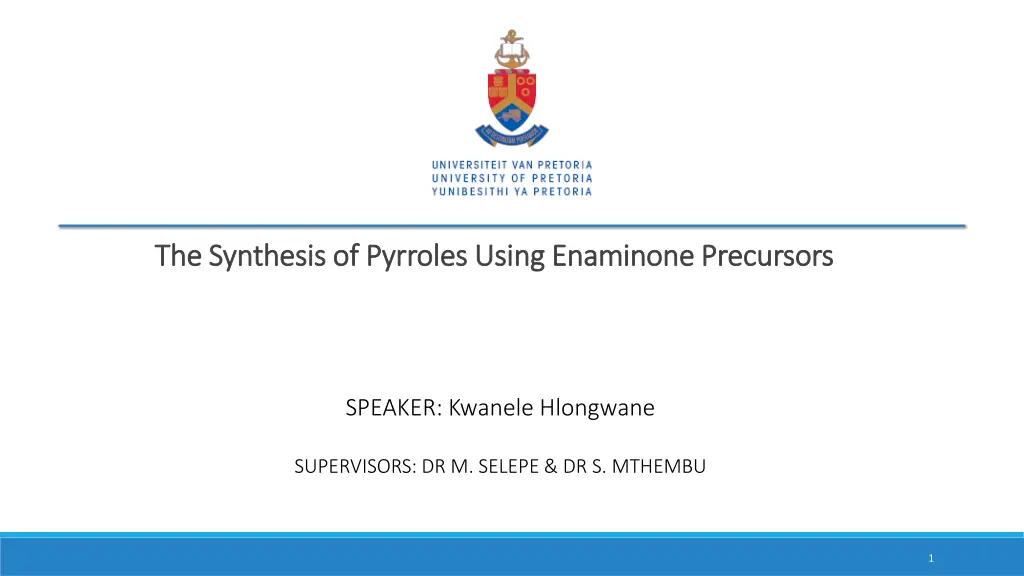
Pyrrole Synthesis Using Enaminone Precursors
Explore the synthesis of pyrroles using enaminone precursors, vital in pharmaceutical applications. The research aims to develop a synthetic approach for pyrrole preparation from enaminone derivatives, with specific objectives focusing on synthesis, characterization, and optimization. Results and discussions include yield percentages and analytical data like NMR and HRMS for synthesized compounds.
Download Presentation

Please find below an Image/Link to download the presentation.
The content on the website is provided AS IS for your information and personal use only. It may not be sold, licensed, or shared on other websites without obtaining consent from the author. If you encounter any issues during the download, it is possible that the publisher has removed the file from their server.
You are allowed to download the files provided on this website for personal or commercial use, subject to the condition that they are used lawfully. All files are the property of their respective owners.
The content on the website is provided AS IS for your information and personal use only. It may not be sold, licensed, or shared on other websites without obtaining consent from the author.
E N D
Presentation Transcript
The Synthesis of Pyrroles Using Enaminone Precursors The Synthesis of Pyrroles Using Enaminone Precursors SPEAKER: Kwanele Hlongwane SUPERVISORS: DR M. SELEPE & DR S. MTHEMBU 1
Pyrroles Pyrrole is a 5-membered aromatic nitrogen-containing heterocycle. They are present in many natural products (heme and chlorophyll), biologically active compounds, and several drugs. Pyrrole derivates have various applications in pharmaceutical and physiologically active drugs like antibiotics, anti-inflammatory drugs, and anticancer agents. 2
Enaminones Enaminones are an essential class of synthetic intermediates that are highly versatile in reactivity because of the O=C C=C N structural part embedded in them. Through their electrophilic and nucleophilic substitution reactions, enaminones are effective as building blocks in the organic synthesis of acyclic, aromatic, and heterocyclic compounds. 3
Aim and Objectives The aim of this research is to develop a synthetic approach for the preparation of pyrroles from the enaminone derivatives. The specific objectives of achieving this aim are:- i. Synthesis of enaminone precursors, ii. Characterization of the synthesized enaminone derivatives using Nuclear Magnetic Resonance (NMR), High-Resolution Mass Spectroscopy (HRMS), and Infrared Spectroscopy (IR). etc., iii. To develop a procedure for the preparation of pyrrole scaffolds, iv. To optimize the pyrrole derivatives, v. To do the bioassay for the enaminones and pyrroles. 4
Methodology Scheme 1: Synthetic route of enaminones to pyrroles. 5
Results and Discussion Table 1: The synthesised enaminone derivatives R H 2,4-dimethyl 4-fluoro 4-chloro 2,3-dichloro 2,4,5-trichloro H 2,4-dimethyl 4-fluoro 4-chloro 2,3-dichloro 2,4,5-trichloro H 2,4-dimethyl 4-fluoro 4-chloro 2,3-dichloro 2,4,5-trichloro Entry 3aa 3ab 3ac 3ad 3ae 3af 3ba 3bb 3bc 3bd 3be 3bf 3ca 3cb 3cc 3cd 3ce 3cf R H H H H H H 4-fluoro 4-fluoro 4-fluoro 4-fluoro 4-fluoro 4-fluoro 4-methyl 4-methyl 4-methyl 4-methyl 4-methyl 4-methyl Yield (%) 81 65 87 84 83 81 95 89 91 96 89 91 96 76 94 92 91 94 6
Results and Discussion a,b e f d,g,h c Figure 2: 1H NMR of compound 3aa. 7
Results and Discussion m/z [M + H]+= 224,1141 Figure 1: HRMS of compound 3aa. 8
Conclusions Successful synthesis of enaminones and its derivates confirmed by NMR and HRMS. Compounds are going to serve as intermediates for the synthesis of the pyrrole derivates. 9
Current and Future Work Synthesis of pyrroles. Biological studies of both enaminones and pyrroles. 10
References 1. S. C. Philkhana, F. O. Badmus, I. C. Dos Reis and R. Kartika, Synthesis, 2021, 53, 1531-1555. 2. I. Siddiqui, D. Kumar and S. Shamim, Journal of Heterocyclic Chemistry, 2013, 50, E111-E115. 3. D. K. Singh and R. Kumar, Beilstein Journal of Organic Chemistry, 2023, 19, 928-955. 4. I. J. Amaye, R. D. Haywood, E. M. Mandzo, J. J. Wirick and P. L. Jackson-Ayotunde, Tetrahedron, 2021, 83, 131984. 11
Acknowledgements Special thanks to my supervisors, Dr Selepe and Mthembu, Research group, University of Pretoria, Chemistry department and the technicians, NRF Free Standing Funding, NRF Thuthuka Funding (Grant No: 0415594923 ), USDP. 12
THANK YOU. THANK YOU. 13
Scheme 16
Mechanism 17






















